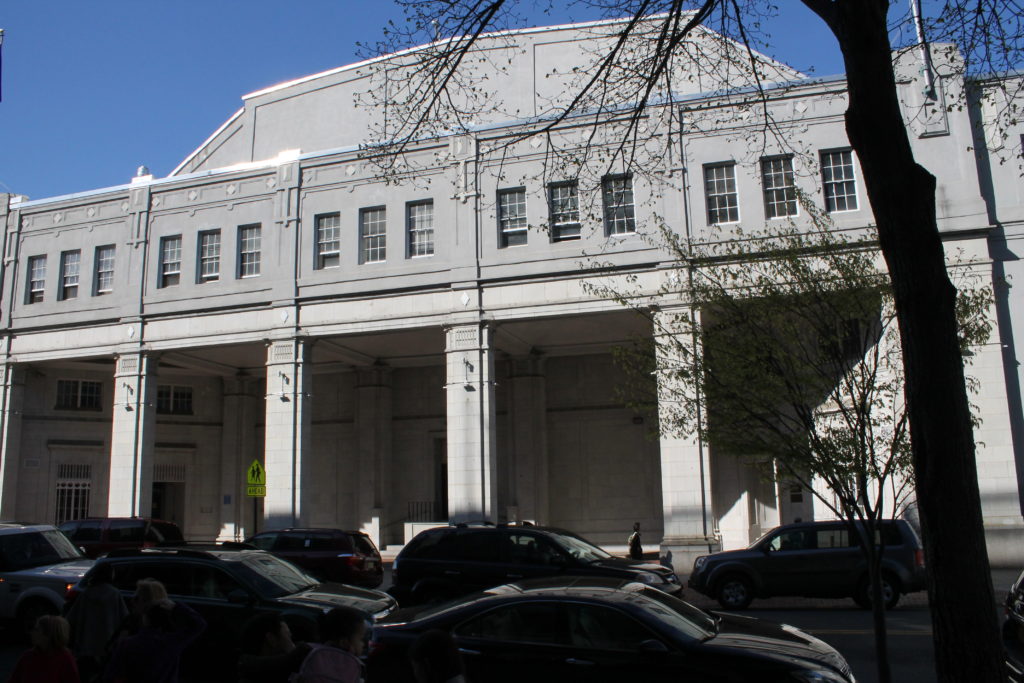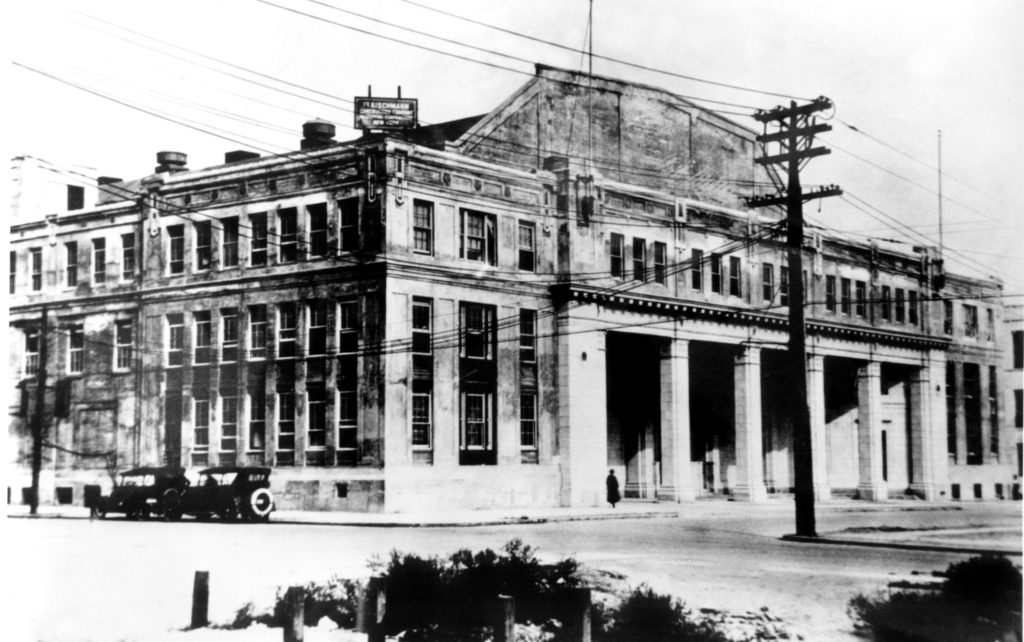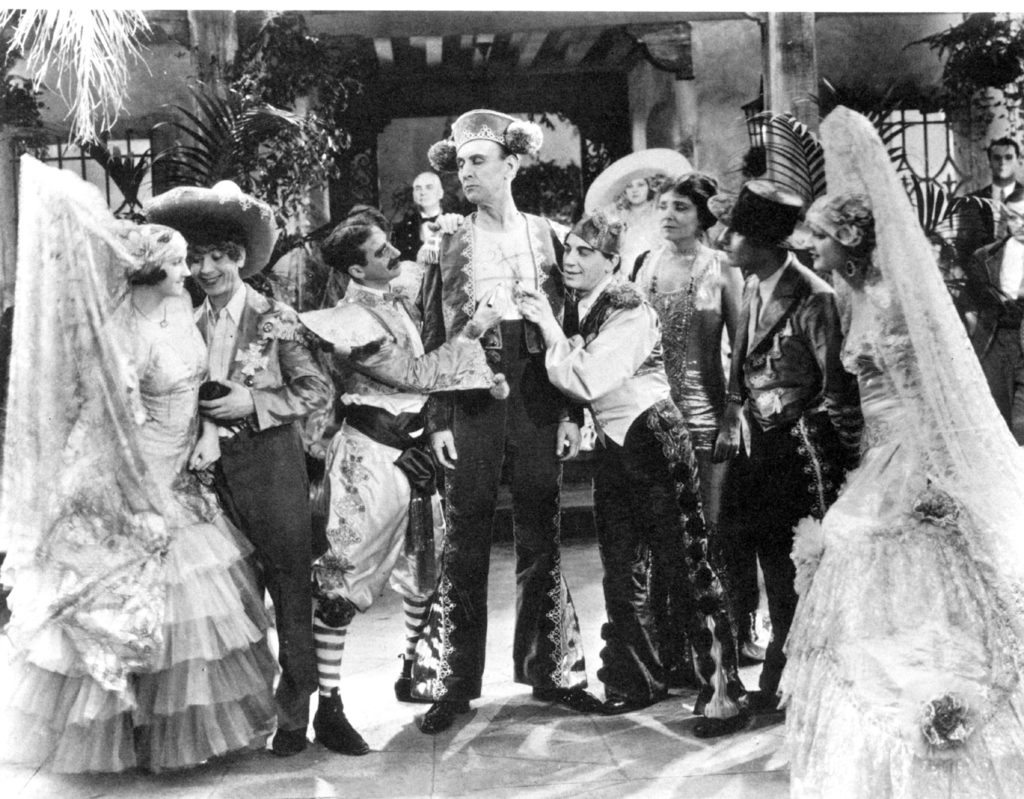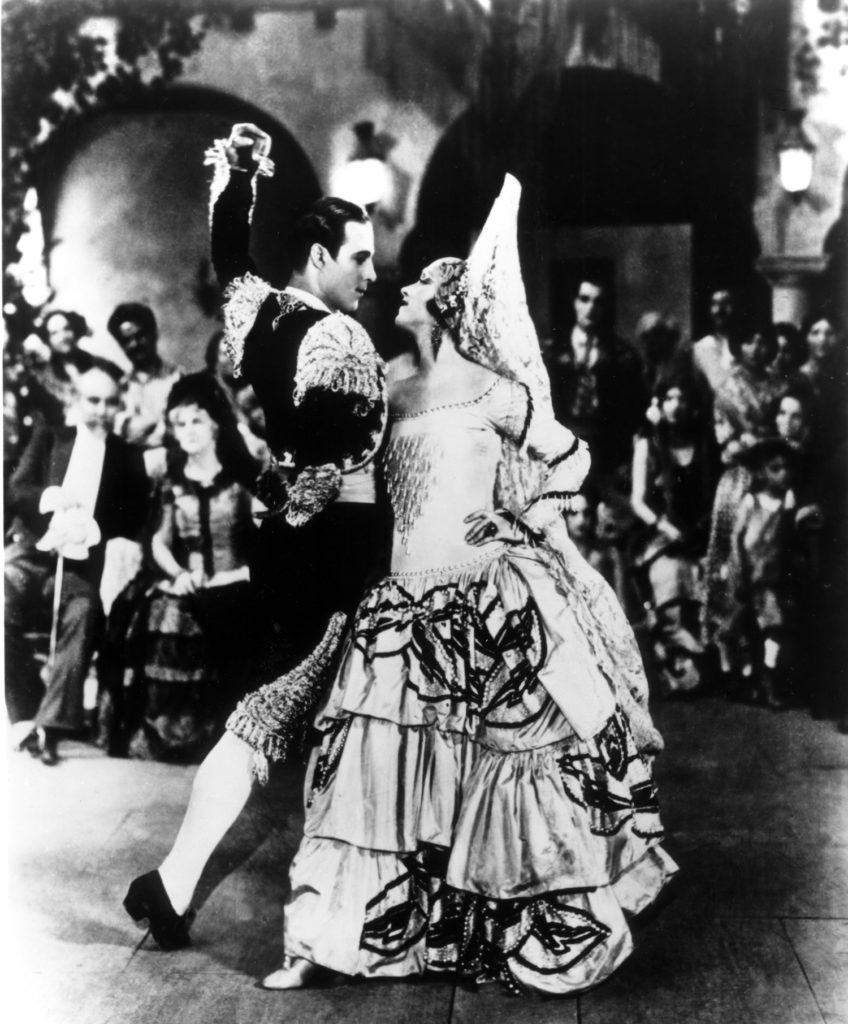This article was originally published on Starring NYC (now sadly defunct) and has been dusted off and spruced up for its Retro Movie Buff debut.
The thumbnail history of American cinema goes something like this: In the beginning, there was Edison. In the 1890s, Thomas Alva Edison—or rather his employee, W.K.L. Dickson—developed the Kinetograph, an early film camera, and the Kinetoscope, a rudimentary device for viewing films. Edison then built the “Black Maria,” America’s first film production studio, on the grounds of his laboratory in New Jersey, and began making movies in earnest. Other filmmakers quickly followed, many of them based in New York City. Edison grew greedy and spearheaded the creation of the Motion Picture Patents Company, a group of studios that licensed filmmakers to use inventions Edison and other members had patented. Newcomers balked at a monopoly designed to force them out of business—the MPCC’s control of patents made it difficult for independent filmmakers to get hold of cameras and film stock—and fled west, to Hollywood.
At this point, all filmmaking in the East, including in New York City, vanished.
Well, not quite. Long after Hollywood became the industry’s glamorous hub, movies were still being made in New York City: newsreels, documentaries, short subjects and feature films.
Production companies built studios all over the city—and the greatest of these was in Queens.
***
On the corner of 35th Avenue and 35th Street, in Astoria, is a plain, slate-grey building that runs the length of an entire block. This is where Big Bird calls home. It has also played host to the Huxtables from The Cosby Show, Henry Hill’s gang in Goodfellas and two installments of the Bourne franchise. Kaufman Astoria Studios has been making films for over 90 years.
The studio was built in 1920 by the Famous Players-Lasky Corporation. Famous Players-Lasky was an amalgamation of the Famous Players Film Company (founded by Adolph Zukor in 1912) and the Jesse L. Lasky Feature Play Company (founded by Lasky the following year). The corporation would eventually adopt the more graceful name of one of its distribution arms, Paramount. By 1918, Famous Players-Lasky had several studios in New York and was also shooting in Fort Lee, N.J.. But since studio space was tight—there were few purpose-built facilities in New York and early studios were usually small lofts with lights— Zukor and Lasky realized they needed to expand.
The end of World War I brought an end to wartime building restrictions and Zukor considered various sites for the company’s custom-built, modern studio. Although director D.W. Griffith had helped make Fort Lee a premier film town by shooting several films there, it could be difficult to reach from New York: There was no bridge or tunnel and the river froze in the winter. Instead, Zukor decided on Long Island City, which was only 15 minutes’ drive from the Famous Players-Lasky offices on Fifth Avenue and a short subway ride from Times Square. He believed shorter travel times made for happier workers, something he emphasized in a 1919 article for the Queens Chamber of Commerce: “Social workers have long told us that the best workman, the most contented and therefore the most generally efficient, is the one who lives near his work. He comes to work without the edge of his enthusiasm being dulled by a tiring trip.”
On April 20, 1919, The New York Times reported Famous-Players Lasky would be building a studio “containing every facility known for the making of high-class motion picture productions.” It would have: open-air and glass-enclosed stages; dedicated rooms for the casting, modeling, wardrobe and props departments; a private cinema for executives and artists; and a special roof to let in as much light as possible, allowing cameramen to shoot using predominantly natural light. In short, everything a cutting-edge studio needed in the 1920s.
And despite the protests of its West Coast offices about the diversion of resources, Famous Players-Lasky needed a studio in New York. Richard Koszarski, a professor at Rutgers University and an expert on early filmmaking on the East Coast, believes the Astoria studio was essential because of its proximity to Broadway. “If you wanted a stage star, a personality like W.C. Fields or someone, who had an active stage career, you could talk them into making films in Astoria. But they would have thought twice, perhaps, about signing a long-term contract to go to the West Coast,” he explained in a phone interview. American cinema thrived on Broadway talent, and every studio was determined to capitalize on the newest plays and performers. The West Coast was for Westerns and Biblical epics—films that required location shooting in vast deserts and canyons. The East Coast was for dramas, comedies and melodramas—a testing ground for performers plucked from Broadway. (“Don’t quit your night job!” became a running gag with stage actors moonlighting in films.) At the Paramount studios in Astoria, the Marx Brothers would shoot The Cocoanuts during the day and dash back across the bridge every night to star in their hit stage show,Animal Crackers. There are moments in the finished movie in which they confuse the two scripts, accidentally performing bits of the latter on-screen. (Animal Crackers itself made it onto screens in 1930.)
Although Paramount wasn’t the only “Hollywood” studio making films in New York, it was unusual for maintaining a full production program. Warner Bros. acquired a studio in Brooklyn and made hundreds of short films there—with the likes of Bob Hope, George Burns and Gracie Allen—but never a feature-length movie. Fox (long before its merger with 20th Century) also built a studio, in Manhattan, and began making feature films, but soon had second thoughts. “It was an inefficient structure that they had built,” Koszarski said. There was no back lot, and the stages were on the third floor of the building—a throwback to when filmmakers constructed studios on top of buildings so that they could have access to glass ceilings and greater light. By 1920, “you really needed direct studio access. You really needed to be able to roll a truck onto the stage with props and scenery, and [Fox] couldn’t do that.” Instead, crews were obliged to pile equipment into freight elevators. “It was not very well thought-out,” Koszarski said, laughing. Fox resigned itself to shooting only short films in New York.
By contrast, Paramount made 30 to 40 percent of its films at Astoria, and the studio became home to two of silent cinema’s biggest stars: Gloria Swanson and Rudolph Valentino. Although Swanson is now best remembered as Norma Desmond, the grotesque caricature of faded fame in Sunset Boulevard, she was American cinema’s original “glamour gal”: Audiences adored her as much for her chic wardrobe as for her lively performances. In the mid-1920s, she was the highest-paid actress in Hollywood. Yet Swanson resented being shunted toward poor-quality scripts and abandoned Paramount’s Hollywood studios in favor of Astoria. “By doing that she became a big fish in a smaller pond,” Koszarski said—the Queen of Astoria, able to choose her own scripts and crew. Valentino also tired of Hollywood and wanted more creative control over his work. He renegotiated his Paramount contract so that he would only have to make films at Astoria. “There was something about Hollywood, the film factory, that was rubbing these people the wrong way,” Koszarski said, chuckling. “People who came from New York, especially in the ’20s, who went to Hollywood, didn’t think very much of the cultural scene on the West Coast.” Louise Brooks, another Paramount star, complained that Hollywood was film-obsessed, insular and culturally sterile—a far cry from New York’s bustling arts scene and nightlife.
Both Swanson and Valentino eventually parted ways with Paramount, and the studio closed the Astoria facility in 1927, only to reopen it 18 months later with the advent of sound. The transition from “silents” to “talkies” was notoriously bumpy—think Lockwood and Lamont making their first “talkie” in Singin’ in the Rain—and American studios relied even more heavily on talent from the theater. Almost every sound film Paramount made at Astoria was an adaptation of a Broadway play or a test run for stage actors—people guaranteed to know how to perform with their voices as well as their faces. Fredric March made six films at Astoria, including The Royal Family of Broadway, a portrait of the Barrymore acting dynasty based on Edna Ferber and George S. Kaufman’s play. Miriam Hopkins made her screen debut at Astoria, and Claudette Colbert, Herbert Marshall and Charlie Ruggles were also Astoria stalwarts. Colbert, Hopkins and Maurice Chevalier all starred in The Smiling Lieutenant, the first Paramount Astoria film to be nominated for a Best Picture Oscar.
In 1932, Paramount moved all its studio operations to the West Coast and rented the Astoria studios out to independent producers, whose films were then released through Paramount. Claude Rains made his first (visible) appearance on US screens in Crime Without Passion, produced by playwrights Charles MacArthur and Ben Hecht; Noël Coward’s first “talkie” was another Hecht-MacArthur production, The Scoundrel. Most controversially, Paul Robeson starred in an adaptation of Eugene O’Neill’s The Emperor Jones—about an African-American who reverts to a more “primitive” existence—reprising the role that helped launch his career on the London stage.
After the United States entered World War II, the Astoria complex was taken over by the War Department and put to work making training films for the Army.
The pre-war Astoria films disappeared into Paramount’s vaults—if they were lucky.
***
Laurence Kardish has spent his whole life at the movies. A fixture in the Museum of Modern Art’s film department since 1968, he retired as MoMA’s Senior Curator in October 2012. Wearing a black jacket, gray shirt and thin, steel-gray glasses, he cradled a steaming cup of tea as he talked about MoMA’s efforts to preserve and restore early films. “Basically what happened to most of the films shot in New York is that they were lost,” he said. “When a film was shown around the country, it was thought, ‘there’s no life beyond that.’ There was no television, no second or third run. [An old film] was like an old automobile or a used spare part. It wasn’t perceived that the work had any value beyond its first or second exhibition life.” But MoMA’s first director, Alfred H. Barr, Jr., insisted that film was an art form and worth preserving. “He wanted MoMA to collect, study, catalogue, research and exhibit films [just as it did] any of the arts, like painting or sculpture,” Kardish said. MoMA’s founders agreed, and the museum’s film program began in 1933, with film critic Iris Barry as its first curator. Barry acquired many of D.W. Griffith’s films—on negatives the director had saved himself—as well as several Edison and Biograph films for MoMA’s collection, but hundreds of other early movies have not survived. “It is estimated that at least 25 percent of all the films that were made pre-1940 are lost,” Kardish said.
Indeed, “the existence of silent films in general is a hit-or-miss proposition,” Koszarski said. In the 1950s and ’60s MGM thought to make copies of its old silent films, but few other studios systematically preserved films. Reasons vary: financial difficulties, a lack of foresight or just bad luck. Most early films were shot on silver nitrate stock, which was not only expensive to preserve, but also a fire hazard. “It was like storing dynamite,” Koszarski said. (Fox’s warehouse blew up in 1937, destroying 40,000 reels of nitrate film.) Worse, silver was at a premium during World War II and hundreds of films were melted down simply to recover the silver in the emulsion. Universal even set up a film reclamation service in 1947 that encouraged cinemas to send in old release prints, so that these too could be boiled down and disposed of.
Among the Paramount Astoria’s missing movies is one of silent cinema’s most famous lost films: the 1926 adaptation of The Great Gatsby. Only the trailer survives.
Preserving and restoring films is an arduous business. “Anything that you see today probably is not taken from the original negative, but from an internegative, because the most valuable thing is the original camera negative. You can’t duplicate that,” Kardish explained. “Sometimes the archive may only receive an exhibition print of the film as it was shown in the movie theatre. But in order to preserve it, or to restore it, you have to try to get back to the original negative, which may no longer exist.” If the original negative is missing, “you have to have a certain degree of connoisseurship to imagine what that negative looked like,” he said. “It’s extraordinarily difficult to do that, and fairly expensive, because it’s all hand-crafted work.”
Restorers compile the best available material from a movie and feed the information into a computer, creating a digital copy. Programmers clean and sharpen the digital images as best they can, and the information is then transferred back onto film. “Film is still the preferred medium for preservation,” Kardish explained, “because the shelf life of motion-picture film is several hundred years, stored correctly. [With] digital imagery, no one knows.” (Digital information degrades over time, forcing archivists to migrate content from one system to another.) Restoration isn’t the same as preservation. A “preservation copy” is akin to a master copy of a movie, while each exhibition print that’s struck from it is a “restored” version of the original work.
The ideal way to store an early film is to keep it cold and dry. In 1978, a cache of silent movies was discovered in a landfill in an abandoned swimming pool in the Yukon—the permafrost had preserved the films. But even the best-kept movies must be shown eventually and as soon as you open the can, the film slowly begins to disintegrate.
Curators are in a constant battle to preserve a unique period in cinema history—and most of it has already been lost forever.
***
Paramount never resumed control of the Astoria studios; the Army remained in residence until 1970, after which the complex fell into disrepair. Yet by then, New York City was enjoying a film renaissance—Best Picture Oscar winners The French Connection, Kramer vs. Kramer and The Godfather were all shot in New York—and people still had great affection for the old studio in Astoria. A group of government officials and industry professionals formed the Astoria Motion Picture and Television Center Foundation in 1977 to revitalize the studio. The site was added to the National Register of Historic Places the following year, and the studio resumed making feature films. All that Jazz, The Purple Rose of Cairo and Moonstruck were all shot there. Property developer George Kaufman took charge of the studio in 1980, hence its current name.
“They managed to not only save the studio building as an architectural landmark, but save it as a significant component of New York’s motion picture and television infrastructure,” Koszarski said.
Still thriving with Men in Black 3, The Affair and Orange Is the New Black, the Kaufman Astoria studios are the city’s best reminder that New York was once “Hollywood East,” and still is.




Leave a Reply